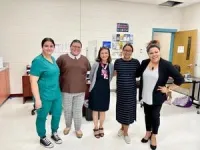(Press-News.org) TAMPA, Fla. (April 1, 2024) – The idea for Fawn Ngo’s latest research came from a television interview.
Ngo, a University of South Florida criminologist, had spoken with a Vietnamese language network in California about her interest in better understanding how people become victims of cybercrime.
Afterward, she began receiving phone calls from viewers recounting their own experiences of victimization.
“Some of the stories were unfortunate and heartbreaking,” said Ngo, an associate professor in the USF College of Behavioral and Community Sciences. “They made me wonder about the availability and accessibility of cybersecurity information and resources for non-English speakers. Upon investigating further, I discovered that such information and resources were either limited or nonexistent.”
The result is what’s believed to be the first study to explore the links among demographic characteristics, cyber hygiene practices and cyber victimization using a sample of limited English proficiency internet users.
Ngo is the lead author of an article, “Cyber Hygiene and Cyber Victimization Among Limited English Proficiency (LEP) Internet Users: A Mixed-Method Study,” which just published in the journal Victims & Offenders. The article’s co-authors are Katherine Holman, a USF graduate student and former Georgia state prosecutor, and Anurag Agarwal, professor of information systems, analytics and supply chain at Florida Gulf Coast University.
Their research, which focused on Spanish and Vietnamese speakers, led to two closely connected main takeaways:
LEP Internet users share the same concern about cyber threats and the same desire for online safety as any other individual. However, they are constrained by a lack of culturally and linguistically appropriate resources, which also hampers accurate collection of cyber victimization data among vulnerable populations.
Online guidance that provides the most effective educational tools and reporting forms is only available in English. The most notable example is the website for the Internet Crime Complaint Center, which serves as the FBI’s primary apparatus for combatting cybercrime.
As a result, the study showed that many well-intentioned LEP users still engage in risky online behaviors like using unsecured networks and sharing passwords. For example, only 29 percent of the study’s focus group participants avoided using public Wi-Fi over the previous 12 months, and only 17 percent said they had antivirus software installed on their digital devices.
Previous research cited in Ngo’s paper has shown that underserved populations exhibit poorer cybersecurity knowledge and outcomes, most commonly in the form of computer viruses and hacked accounts, including social media accounts. Often, it’s because they lack awareness and understanding and isn’t a result of disinterest, Ngo said.
“According to cybersecurity experts, humans are the weakest link in the chain of cybersecurity,” Ngo said. “If we want to secure our digital borders, we must ensure that every member in society, regardless of their language skills, is well-informed about the risks inherent in the cyber world.”
The study’s findings point to a need for providing cyber hygiene information and resources in multiple formats, including visual aids and audio guides, to accommodate diverse literacy levels within LEP communities, Ngo said. She added that further research is needed to address the current security gap and ensure equitable access to cybersecurity resources for all Internet users.
In the meantime, Ngo is preparing to launch a website with cybersecurity information and resources in different languages and a link to report victimization.
“It’s my hope that cybersecurity information and resources will become as readily accessible in other languages as other vital information, such as information related to health and safety,” Ngo said. “I also want LEP victims to be included in national data and statistics on cybercrime and their experiences accurately represented and addressed in cybersecurity initiatives.”
###
About the University of South Florida
The University of South Florida, a high-impact research university dedicated to student success and committed to community engagement, generates an annual economic impact of more than $6 billion. With campuses in Tampa, St. Petersburg and Sarasota-Manatee, USF serves approximately 50,000 students who represent nearly 150 different countries. For four consecutive years, U.S. News & World Report has ranked USF as one of the nation’s top 50 public universities, including USF’s highest ranking ever in 2023 (No. 42). In 2023, USF became the first public university in Florida in nearly 40 years to be invited to join the Association of American Universities, a prestigious group of the leading universities in the United States and Canada. Through hundreds of millions of dollars in research activity each year and as one of top universities in the world for securing new patents, USF is a leader in solving global problems and improving lives. USF is a member of the American Athletic Conference. Learn more at www.usf.edu.
END
Researchers at the University of Colorado School of Medicine are hopeful new research could prevent up to 130,000 unneeded fine-needle aspiration (FNA) biopsies of thyroid nodules and subsequent surgeries each year in the United States by better understanding the genetic risk associated with thyroid cancer.
Through an R21 grant from the National Institutes of Health, Nikita Pozdeyev, MD, assistant professor of biomedical informatics, Chris Gignoux, PhD, professor of biomedical informatics, and Bryan Haugen, MD, professor of medicine and head of the Division of Endocrinology, Metabolism, and Diabetes, will study new strategies that could pave the way ...
Nearly every modern cellphone has a built-in compass, or magnetometer, that detects the direction of Earth’s magnetic field, providing critical information for navigation. Now a team of researchers at the National Institute of Standards and Technology (NIST) has developed a technique that uses an ordinary cellphone magnetometer for an entirely different purpose — to measure the concentration of glucose, a marker for diabetes, to high accuracy.
The same technique, which uses the magnetometer in conjunction with magnetic materials designed ...
Frisch To Conduct Research On Healing The Traumatized Body In Second Temple Judaism
Alexandria ...
FOR IMMEDIATE RELEASE
Monday, April 1, 2024
Contact:
Jillian McKoy, jpmckoy@bu.edu
Michael Saunders, msaunder@bu.edu
##
Reducing Late-Night Alcohol Sales Curbed All Violent Crimes by 23% Annually in a Baltimore Neighborhood
A new study found that reducing alcohol hours of sale for bars and taverns in a Baltimore, Md. neighborhood also reduced homicides by 51 percent within the first month and by 40 percent annually, pointing to possible opportunities for other cities to address excessive drinking and crime.
Simply reducing the hours during which alcohol may be purchased can significantly reduce violent crime, ...
“[...] our findings suggest that diminished brain volume and functional connectivity may be linked to menopause-related symptoms caused by the lower sex hormone levels.”
BUFFALO, NY- April 1, 2024 – A new research paper was published on the cover of Aging (listed by MEDLINE/PubMed as "Aging (Albany NY)" and "Aging-US" by Web of Science) Volume 16, Issue 6, entitled, “Altered brain morphology and functional connectivity in postmenopausal women: automatic segmentation of whole-brain and thalamic subnuclei ...
Among the many chemicals we use every day, ammonia is one of the worst for the atmosphere. The nitrogen-based chemical used in fertilizer, dyes, explosives and many other products ranks second only to cement in terms of carbon emissions, due to the high temperatures and energy needed to manufacture it.
But by improving on a well-known electrochemical reaction and orchestrating a “symphony” of lithium, nitrogen and hydrogen atoms, University of Illinois Chicago engineers led by Meenesh Singh have developed a new ammonia production processthat meets several green targets.
The process, called ...
In the realm of science and technology, harnessing coherent light sources in the deep ultraviolet (DUV) region holds immense significance across various applications such as lithography, defect inspection, metrology, and spectroscopy. Traditionally, high-power 193-nanometer (nm) lasers have been pivotal in lithography, forming an integral part of systems used for precise patterning. However, the coherence limitations associated with conventional ArF excimer lasers hinder their effectiveness in applications requiring high-resolution patterns, like interference lithography.
Enter the concept of the "hybrid ArF excimer laser." ...
WASHINGTON, D.C., April 1, 2024 — The latest issues of three American Psychiatric Association journals, The American Journal of Psychiatry, Psychiatric Services and The American Journal of Psychotherapy are now available online.
The April issue of The American Journal of Psychiatry features studies that focus on youth psychopathology. Highlights include:
Promising clinical results and neuroimaging findings seen in a double-blind trial of intranasal oxytocin for irritability. (AJP Deputy Editor Danny Pine highlights the study in this video and lead author Soonjo Hwang is the featured guest on April’s AJP Audio podcast episode.)
A critical integrative review of irritability ...
Using a blink-and-you’ll-miss-it experiment, researchers from Trinity College Dublin have discovered that individuals differ widely in the rate at which they perceive visual signals. Some people perceive a rapidly changing visual cue at frequencies that others cannot, which means some access more visual information per timeframe than others.
This discovery uggests some people have an innate advantage in certain settings where response time is crucial, such as in ball sports, or in competitive ...
As computer vision (CV) systems become increasingly power and memory intensive, they become unsuitable for high-speed and resource deficit edge applications - such as hypersonic missile tracking and autonomous navigation - because of size, weight, and power constraints.
At the University of Pittsburgh, engineers are ushering in the next generation of computer vision systems by using neuromorphic engineering to reinvent visual processing systems with a biological inspiration - human vision.
Rajkumar Kubendran, assistant professor ...







